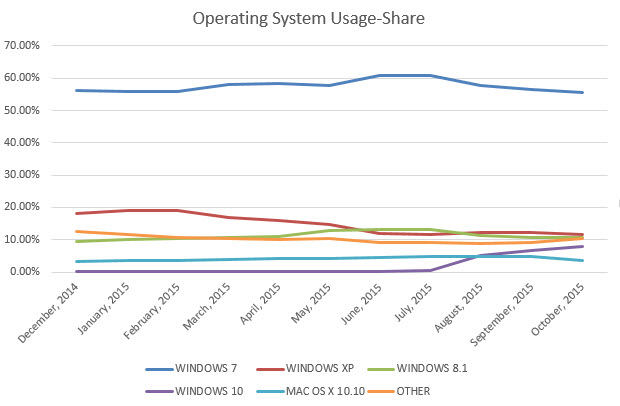Windows 10 continues to do well usage-share wise
How well is Microsoft's Windows 10 operating system doing after three months, and is its growth slowing down or picking up?
Usage-share stats from companies like NetMarketShare are one indicator of how well an operating system is doing after its release.
While the stats are not accurate, as they are based on large sample sizes instead of hard value which only Microsoft could provide, they do highlights trends.
So, how are things for Microsoft's Windows 10 operating system?
The rise continues from 6.63% in September 2015 to 7.94% in October 2015, an increase of 1.31%. Microsoft's other operating systems have dropped ever so slightly: Windows 7 fell from 56.53 to 55.71, Windows XP from 12.21% to 11.68%, and Windows 8.1 from 10.72% to 10.68%.
Growth is slowing down a bit but that was to be expected since most customers interested in the free upgrade offer should have accepted it and upgraded their system to Windows 10 by now.

Microsoft plans to deliver Windows 10 directly via Windows Update early next year which may push Windows 10 on systems running Windows 7 or Windows 8 and increase growth again.
The almost 8% of usage-share makes Windows 10 the fourth most popular desktop operating system trailing Windows XP and Windows 8.1 by less than four percent.
If the current trend continues, it will have surpassed both operating systems in less than four months to become the second most popular operating system.
Windows 10's real contender is Windows 7 however and it seems currently that the majority of Windows 7 users have no interest in the free upgrade offer to Windows 10.
And why should they? First, they have until next year to take Microsoft up on the offer. At least some are waiting for the first big feature update which Microsoft plans to deliver next year before they make a decision.
The latter makes sense in a number of ways. First, it allows customers who are waiting to assess the state of the system after the first big update patch. While Windows 10 runs fine when it comes to day to day tasks already, it is apparent that it is in an unfinished state currently.
November's Threshold 2 patch is a first step towards that goal bringing new apps and improvements across the board to the operating system.
Another reason may be that customer's don't want to be burned by another Windows Vista / Windows 8 fiasco. What I mean by that is that it is not clear yet if Windows 10 will be a top priority for Microsoft in the foreseeable future, or if the company will move away from it quickly, like it has done with Windows 8, to create another operating system to sway consumers.
It is unlikely that Windows 10 will share the fate of Windows 8 though unless growth slows down to a crawl in the coming months.
Other customers may not be interested in Windows 10 because of the data collection that is going on, or because they don't want to change a running system.
Considering that Windows 7 is supported until January 2020 with security patches, there is no need to hurry a decision.
Now You: Where do you see Windows 10 in a year?
This article was first seen on ComTek's "TekBits" Technology News

- Log in to post comments